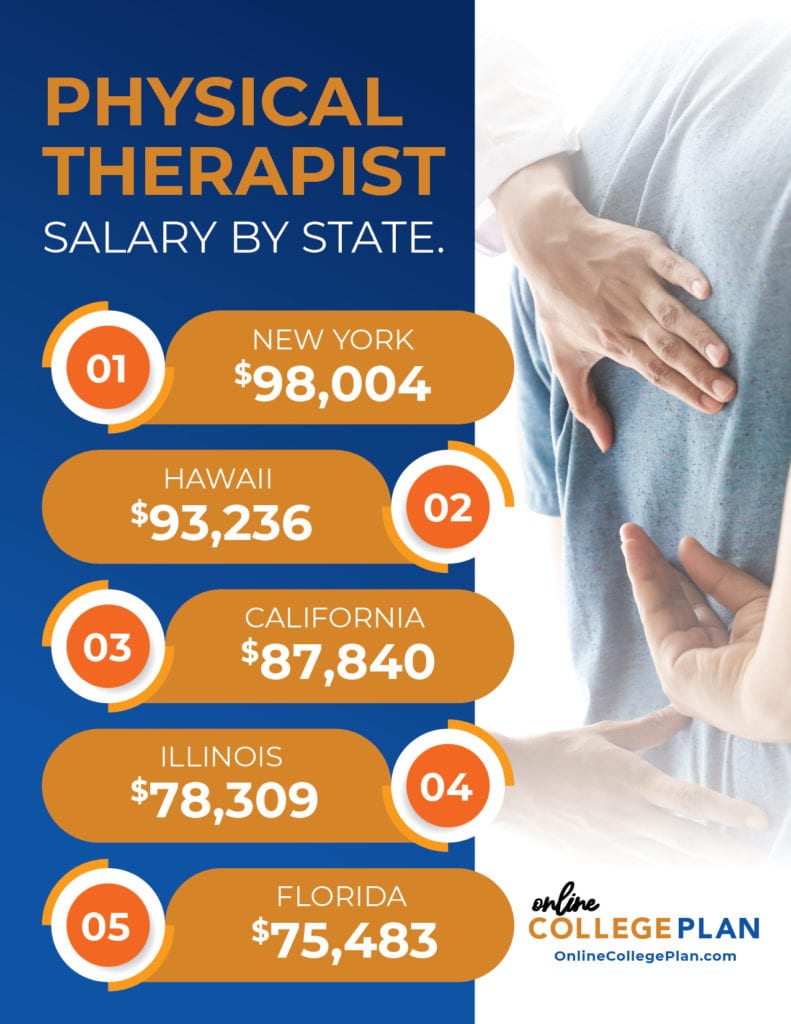How do I Become a Physical Therapist?
Find your degree
by Jennifer W. Eisenberg

If you are interested in the process of becoming a physical therapist, we have answered commonly asked questions and connected the dots from the physical-therapy-curious high school or college student to the practicing Ph.D. of physical therapy. We cover areas of specialization, the educational process, various techniques utilized by these doctors in their treatments of patients, and a few of the governing bodies that oversee the education of would-be physical therapists.
Physical therapy is predicted to outpace other jobs in employment demand over the next two years. There is no reason to believe that demand will drop off after that, considering the aging population and increasing access to healthcare. In contemplating physical therapy as a career, the first thing you should take into account is your own physical health and energy levels. The labor for this is as physically demanding as it is intellectually and emotionally. In this article, we have tried to answer most of the questions surrounding how to become a physical therapist. What to expect for training and practice, what financial compensation in the field looks like, what kind of degree is called for, and other relevant questions are the points we set out to cover with this piece.

What does a physical therapist do?
A physical therapist works with a patient to strengthen or maintain (or gain) flexibility after an injury, as part of a surgical recovery, or as part of the treatment of a chronic condition. Physical therapists can also help with the management of chronic pain. Some further treatments you will be expected to perform include dry needling (which is a Western form of acupuncture), aquatic therapy, varied forms of strength training, chronic ailment management and relief, which can be for the very young through the very old, depending on where your area of focus is, and what the client requires. Most people are familiar with the acute care facet of PT that they have encountered for so many prescribed visits after an injury or surgery. But there is more to the field than that. First of all, many physical therapists have an area of specialization and extended training in a skill or technique to aid in healing. Second of all, physical therapists don’t just operate in physical therapy offices. They are integral members of athletic training programs and the staff of hospitals, nursing homes, and rehabilitation centers.
How much schooling do you need to be a physical therapist?
The Doctor of physical therapy is a post-baccalaureate program that can be completed in 2-3 years, after which there is a residency period, and then the student will begin to practice full or part-time with the new PT doctoral degree. Though there are a number of paths to becoming a PT, several sources recommend maintaining grades, practicing and maximizing test scores, taking the appropriate science courses, and maintaining current knowledge of the trends in the field. The latter path will keep you conversant when you are able to get into a university program while also making your decisions about what you feel would be your preferred focus and the best approach to training. After graduating with a degree in physical therapy, you would be well-served to look into residencies and fellowships, which is where the specialization of your training will occur. Residency programs exist in the following specialties: wound management; pediatrics; cardiovascular & pulmonary health; clinical electrophysiology; sports; geriatrics; neurology; orthopedics; oncology; women’s health; and acute care. The residency lasts long enough for the student to gain the expertise to become board certified by the American Board of Physical Therapy Residency and Fellowship Education (ABPTRFE). This body also oversees fellowships that serve the purpose of following the residency and being an even deeper dive into one or more of the following subjects: critical care; movement system; hand therapy; upper extremity athlete; spine; performing arts; neonatology; sports division I; or orthopedic manual physical therapy. Furthermore, the ABPTRFE furnishes the tests used by many fellowships and residencies to screen applicants who are interested in pursuing study in advanced physical therapy.

How much does a physical therapist make per year?
The US Bureau of Labor Statistics states that physical therapists make an average of $89,440 in yearly compensation. Starting salaries are in the mid-sixties, and some locations are more highly remunerated than others, including the following: California, Nevada, Alaska, and New Jersey. The BLS also says to expect growth in this and related fields at 36 percent, which far outstrips just about any other industry due to the inherent intimate level of contact that can’t easily be replaced by automated support services. That growth should also further professionalize this aspect of the labor force, which means that you will need to keep current regarding changes in the technological elements of health service delivery.
What does one major in to become a physical therapist?
Some good majors for physical therapy include exercise science, kinesiology, exercise sciences, physiology, and general health sciences. The important thing is that students have a good background in anatomy, physiology, biology, physics, chemistry, and psychology. There is no specific major required for undergraduates who wish to pursue physiotherapy as a career. As long as the prerequisites in the areas listed above for admission to the doctoral program are met, the overall major does not matter. As has been mentioned elsewhere, some students enter the physical therapy doctoral program directly out of high school, so no major is necessary, though some focusing of your high school coursework (chemistry, physics, anatomy, et al, as specified above) is highly recommended. Another facet of physical therapy will include the supervision of trained physical therapy assistants, so if you can add some people-managing skills to your professional quiver, that will also be of value. These skills will also aid you in managing patients doing difficult exercises or generally being difficult. In addition, your decision to develop the ability to interact with people and manage individuals and groups could never be a bad idea. The young holder of a doctoral degree in physical therapy cannot foresee that he or she may one day be in charge of a multitude of employees who may be caring for hundreds or even thousands of patients. The more management skills you have, the better prepared you will be for whatever your future holds.

Do physical therapists need doctoral degrees?
While there are doctoral degrees in physical therapy, a doctorate is not required to work in the field. The program should be accredited by the Commission on Accreditation in Physical Therapy Educations (CAPTE), which is a quality-assurance organization that ensures all schools awarding this degree maintain programs within certain parameters for education and training. Typically, as with other conventional degrees, the theory is studied and followed up by application in clinical settings. As with any other doctoral program, the rigor of the coursework will certainly keep you sharp, providing you feel up to the demands of that kind of program. The more you learn, the more applicable your study will become, whatever clinic you happen to be a part of. As a result, ideally, you should be ready for positions of authority and even leadership. But there are positions in this field that do not require a doctorate, and those job titles are not, per se, physical therapists. The physical therapy assistant position can be occupied by anyone who has completed the associate’s degree and received licensing in this area. Training for this position will require coursework in kinesiology, therapeutic exercise, and assistive devices, among others. PTAs can expect to make a yearly salary in the middle fifties, depending on location and specialization.
Is it hard to become a physical therapist?
Physical therapy is a rewarding field that holds the distinction of being a relatively low-stakes medical field. Can you improve people’s quality of life? Absolutely. Is someone going to die if you misplace a decimal? Less than is usually likely in other areas of medicine. The schooling is, of course, rigorous and thorough, but a reasonable scientific aptitude should see you through. You will likely need to develop a sense of patient need and calmness that will be appreciated by the folks you work with as well. Speaking anecdotally, a few colleagues we have known for many decades have made excellent livelihoods in the Las Vegas area, where the demand for this service has only gone up. Some physical therapy programs allow students to enter the program directly from high school and pursue the doctorate without any previous college experience, though these students have taken specialized coursework in their high school career. Upon graduation from a PT program, all students must submit themselves to the National Physical Therapy Examination (NPTE) to pass with an acceptable score and meet their state of residence’s standards for professional licensing.

What are the job prospects for physical therapists?
Job prospects for physical therapists are exceedingly rosy at the moment. The aging population is at an all-time high, and thanks to programs like Obamacare, more people of all ages have access to health insurance benefits like physical therapy, so the outlook is great for this particular field. In addition, some of the populations most in need of physical therapy services, such as those with diabetes or obesity, are also on the rise and will contribute to the strong demand for these skills. If you are in the military or about to enter one of the armed services, keep in mind that the Veterans Administration employs more than 3,500 physical therapists and physical therapy assistants and has the largest physical therapy residency program in the nation. Typically, physical therapists in VAs rise up from the military but not exclusively.
What are the different types of physical therapy?
There are eight distinct areas of physical therapy: pediatric physical therapy; vestibular rehabilitation; geriatric physical therapy; orthopedic physical therapy; neurological physical therapy; sports therapy; women’s health; and cardiovascular/pulmonary physical therapy. Another way that fields of physical therapy are distinguished is in the situations where physical therapy is accomplished. The types of physical therapy listed above are often practiced in varying locations, from hospitals and rehabilitation centers to sole practice offices and nursing homes.
Various techniques that can be used to achieve the goals of physical therapy include the following: aquatic therapy; sports therapy; therapeutic exercise; electrical stimulation; light therapy; soft tissue mobilization; and patient education. That last one may be the most important aspect of what a physical therapist does because if patients don’t understand the purpose or long-term goal of their regimen, they are unlikely to stick with it or pursue it with great dedication.
Do you need to be licensed to be a physical therapist?
Licensing of physical therapists is required in all 50 states. Many states coordinate and use the same licensing exam, but other states have their own exam, so be aware of what your intended state of residence requires. There is also a national standard for an exam that must be passed before the professional portion of your career can commence.

Are there career organizations that a physical therapist can join?
As a physical therapist, you will have the option of becoming affiliated with organizations of like-minded people. Such organizations exist to improve your working life, your prestige, and your knowledge in your field. Aside from individual state organizations, a couple of associations stand paramount. The APTA, American Physical Therapist Association, was founded in 1921 and has more than 100,000 members. The WCPT, World Confederation for Physical Therapy, boasts 350,000 members worldwide and has 106 member organizations.
The field of physical therapy can be a very rewarding career, one in which you actively help people, receive very comfortable pay, and where one can be assured that the demand will increase. Physical Therapy is a career option worth looking into!
Related Articles:
What Can I Do With a Doctor of Occupational Therapy Degree?
